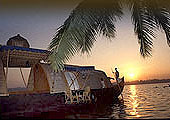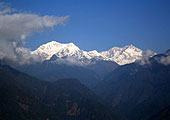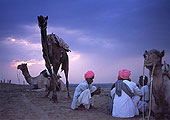01 Day: Arrival Mumbai
Meeting and assistance on arrival at the airport, our representative welcome and escort you by a private car and transfer to the hotel, whilst the room keys and check-in is organized, our representative would hand over the documents and brief the tour programme to you. Overnight at the hotel.
Mumbai is a cluster of Seven Islands and derives its name from Mumbadevi, the patron goddess of the koli fisher folk, its oldest inhabitants. Mumbai pulsates with activity. It is a city that is disciplined by no time frame, neither day nor night. It is also the country's financial powerhouse, the nation's industrial heartland, and its economic nerve center. Dazzling shopping arcades, exciting sport activity, nightclubs & discotheques, theatre & music, gourmet restaurants and interesting sightseeing. It offers visitors a heady mix of all this and more.
02 Day: Mumbai
After breakfast, take a sightseeing tour of Mumbai drive to Gateway of India and from here cruise by motorboats to Elephanta Caves. A flight of 100 steps takes you to the top of the hill where it is set. The caves houses large pillars that seem to hold the ceiling, which is made, have crossbeams. The picturesque presentations of the 9 marvelous sculptured panels, set on the walls are awe-inspiring. The most famous of the panels is the Trimurthi, or triple-headed Shiva, where the God is depicted as the destroyer, the preserver and the creator. Later in the afternoon cruise back to Gateway of India, one can have lunch at the hotel or other several good Restaurants like Leopold & Mondegar serving continental cuisines. Later visit Prince of Wales Museum, Taraporewala Aquarium, Parliament House, Marine Drive, Jain Temple, and Hanging Garden. Return back to the hotel for overnight stay.
Note: Elephanta Caves and Prince of Wales museum are closed on every Monday.
03 Day: Mumbai – Aurangabad (By Air) – Ajanta (105 kms: 2 hrs)
After breakfast take an excursion to the famous Ajanta caves. Ajanta is one of the few historical and architectural marvels of India. Recognized as the World Heritage Site today, it was discovered during the 19th century by a group of British officers who were on a tiger hunt. The Ajanta group of caves, located deep within the Sahyadri hills above the Waghora, depicts the story of Buddhism that prevailed here during 200 BC to 650 AD. Ajanta’s wondrous cave temples are cut into the rocky sides of a dramatic crescent-shaped gorge, at the head of which is a waterfall that drops over the mountain rim in a series of seven steps to a pool far below –deep inside the mountain are the Buddhist chaitya – Vihara prayer and monastery caves. They cover a span of 800 years where under the royal patronage of ruling dynasties, professional artists helped Buddhist monks to create magnificent murals narrating the story of Buddha in his cycle of incarnations, while simultaneously creating a painted record of the panorama of life in ancient India. Etched and painted in mineral dyes, the paintings have a languorous stylized beauty and magical eloquence. Overnight at the hotel.
Note: The Ajanta Caves are closed to public on all Monday and Ellora caves on Tuesday
Aurangabad: Malik Ambar, the Prime Minister of Murtaza Nizam Shah II, founded the city of Aurangabad in 1610 A.D, on the site of a village, Khirki. When Fateh Khan, Malik Ambar's son succeeded the throne in 1626, he named the city 'Fatehpur'. In 1653, when Aurangzeb became the Viceroy of the Deccan, he made it his capital, and renamed it Aurangabad. Maurya rule heralded the advent of Buddhism in the state of Maharashtra. The earliest caves at Ajanta and Pithalkora were excavated in the 2nd century BC, during the Satvahana era. Paithan, then known as Pratishthana, was an important trade centre at the time Aurangabad, 400 kms from Bombay, is linked by air too. Spectacular rock cut caves and cave paintings exist at two nearby places, Ajanta and Ellora.
Ajanta: It was only in the 19th century, that the Ajanta group of caves, lying deep within the Sahyadri hills, cut into the curved mountain side, above the Waghora river, were discovered. A group of British officers on a tiger hunt, stumbled on these ancient works of art. They depict the story of Buddhism, spanning the period from 200 BC to 650 AD. The 29 caves were built as secluded retreats of the Buddhist monks, who taught and performed rituals in the Chaityas and Viharas, the ancient seats of learning, and nerve - centers of the Buddhist cultural movement.
04 Day: Aurangabad – Ellora (30 kms: ½ hrs)
After breakfast take a sight seeing tour of Ellora, one of the highly visited World heritage sites of India. It houses 34 monasteries and temples with some exclusive uninterrupted sequence of monuments that date back from 600 to 1000 AD. The temples of Ellora are dedicated to Brahmanism, Jainism, and Buddhism. It also has some of the excellent stonework depicting the legends related to Lord Shiva. After visit return back to Aurangabad. Later visit to Bibi ka Maqbara Built by Azam Shah in 1678, the Bibi ka Maqbara is a son's loving tribute to his mother, Begum Rabia Durrani, the Queen of Mughal emperor Aurangzeb. Standing spectacularly on the lawns of the landscaped garden with ponds, fountains and water channels, the white marbled monument rises majestically in an intentional bid to copy and rival the world famous Taj Mahal of Agra and Panchakki - An engineering feat of the time is the Panchakki, or the water mill built by Malik Ambar in 1695. The water, channeled from a spring on a distant hill was used to power the flourmill and grind grain for the pilgrims. Rest of the evening is free to enjoy city atmosphere. Overnight at the hotel.
Note: The Ajanta Caves are closed to public on all Monday and Ellora caves on Tuesday
Ellora: The Ellora caves, 34 in number, are carved into the sides of a basaltic hill, 30 kms from Aurangabad. The finest specimens of cave - temple architecture, they house elaborate facades and exquisitely adorned interiors. These structures representing the three faiths of Hinduism, Buddhism and Jainism, were carved during the 350 AD to 700 AD period. The 12 caves to the south are Buddhist, the 17 in the centre dedicated to Hinduism, and the 5 caves to the north are Jain.
05 Day: Aurangabad – Delhi (By Air)
After breakfast, check out of the hotel and drive to the airport to board the flight for Delhi. On arrival, transfer to the hotel. Later take sightseeing tour of historic city visiting Old Delhi: the majestic Red Fort, a marvel in red sandstone, Jama Masjid, the largest mosque in India, both built by emperor Shah Jahan of Taj Mahal fame, Rajghat - memorial of Mahatma Gandhi & a Rickshaw ride past through the silver street in Chandani Chowk, Later take a sight seeing tour of New Delhi includes Rashtrapati Bhawan, one-time imperial residence of the British viceroys; the India Gate, a memorial raised in honour of the Indian soldiers martyred during the Afghan war; the Laxmi Narayan Temple, built by the Birlas, one of India’s leading industrial families; Humayun’s Tomb, lotus shaped Bhai’s Temple, Qutub Minar , built by Qutub-ud-din Aibek of the Slave Dynasty. In the evening you can visit see light and sound show at Red fort. Overnight at the hotel.
Delhi, capital city of the Federal Republic of India. It is one of India's fastest growing cities. It has sprawled over the West Bank of the river Yamuna, straddling the river. Delhi blends an historic past and a vibrant present. Delhi has some of the finest museums in the country. New Delhi was proclaimed the capital of India by the British architect Sir Edwin Lutyens (1869-1944) & is tree-lined & spacious. Legend has it that the Pandavas, the august heroes of the epic Mahabharata, originally founded Delhi, then called Indraprastha, around 1200 B.C. Present day Delhi is built around the ruins of seven ancient cities.
Light and Sound Show: A spectacular sound and light show at the Red Fort. Which makes the 5,000 years old history of the city come alive. Amidst the tranquility of the splendidly panoramic and historic environs of the Red Fort, select episodes from the annals of Delhi's historic and legendary past are vividly brought to life. Special effects combine with the unique ambience to make this show a hauntingly unforgettable experience.
06 Day: Delhi – Varanasi (By Air)
After breakfast, check out of the hotel and drive to the airport to board the flight for Varanasi. On arrival, transfer to the hotel. Later take an excursion tour to Sarnath, located at 10 Kms from Varanasi where Lord Buddha gave his first sermon to the five holy men; visit at Dharmarajika Stupa The 110 ft tall Dhamekh Stupa marks the place where Buddha preached first sermon., also visit to Archaeological museum, the collection of ancient Buddhist relics and antiques comprising numerous Buddha and Bodhisatva images, also see the Ashok Pillar with 4 lions, built in 3rd Centaury BC., symbolize both Ashoks's imperial rule and the kingship of the Buddha. The four-lion capital was adopted as the emblem of the modern Indian republic. In the evening walk through the myriad of narrow lanes in the old city, past the many ancient temples, shrines and little shops crammed with customers looking for the famous silver & gold brocades for weddings or even for cremation cloth. Explore the oldest cultural city of India, by visiting the most famous temple; Kashi Vishvanath or Golden temple which, though off-limits to non-Hindus, can be seen from the top floor of the old house opposite it, strolling in narrow lanes of the colourful bazaar of ancient city. Followed by the Bharat Mata temple with a big relief map of India in marble, Durga temple, Tulsi Manas Mandir. Overnight at the hotel.
Varanasi: Sandwiched between the rivers Varuna and Ashi as they join the Ganges, Varanasi takes its name from its location. It is also called Kashi, the city of light, but the British, in an endeavor to simplify matters, had coined their own name for the place—Benaras. Varanasi is the city of a thousand temples. The main object of all devotees is the Kasi Vishwanath Temple. According to Hindu belief, Benaras or Varanasi as it is known, is the cosmic center of the Universe. The renowned American novelist Mark Twain once wrote, "Benaras is older than history, older than tradition, older even than legend and looks twice as old as all of them put together
07 Day: Varanasi – Bodhgaya (190 kms: 4 hrs)
Early morning take a boat ride for a pilgrimage from ghat to ghat. People bathe early in the morning to offer the prayers to the rising sun. The two cremation ghats are Manikarnika & Harishchandra where funeral pyre burns day and night. Every pious Hindu believes that to die in Kashi and to be cremated on banks of the Ganges is to attain release from the cycle of birth and death. Varanasi - Hindus holiest city and one of the oldest living cities in the world. Varanasi was already old when Rome was founded, a flourishing trade centre when the Buddha came to Sarnath to preach his first sermon. It was a city of great wealth and religious important when the Chinese travelers Hiuen Tsang visited in the 7th century. Also visit the Banaras Hindu University which has an Art Gallery and the Mosque of Mughal Emperor Aurangzeb built on the site of an ancient Hindu temple. Later check out of the hotel and drive to Bodhgaya. On arrival, transfer to the hotel. Overnight at the hotel.
Bodhgaya is one of the sacred places for the Buddhists as well as for the Hindus. Here under the Bodhi Tree, Gautama attained supreme knowledge to become Buddha, the `Enlighted One'. The Buddha attained enlightenment in Bodhgaya, under the Bodhi tree, which still stands in the temple premises. The magnificent Mahabodhi temple in Bodhgaya is an architectural amalgamation of many centuries’ cultures and many heritages that came to pay their homage here. The temple definitely has architecture of the Gupta and later ages, inscriptions describing visits of pilgrims from Sri Lanka, Myanmar and China between 7th and 10th century AD.
08 Day: Bodhgaya
After breakfast visit to Mahabodhi Temple. Bodhgaya- the place where Lord Buddha attained Enlightenment under the sacred Bodhi Tree followed by visit to Chinese Temple. In the afternoon visit Niranjana Temple and River. Evening is free at leisure or you can explore the surroundings on your own. Overnight at the hotel.
09 Day: Bodhgaya – Rajgir – Nalanda – Patna (180 kms: 4 hrs)
After breakfast check out of the hotel and drive to Patna. En route visit Nalanda & Rajgir. Nalanda is believed to be the oldest university in the world. Founded in the 5th century BC, it became a renowned centre of Buddhist and Jain learning. Hiuen Tsang, the Chinese traveller, spent several years here in the 7th century AD. Nalanda Archaeological Museum has a magnificent collection of Pali and Mauryan statues, bronze and manuscripts. Nalanda Mahavihara an institute for the study of Pali literature houses rare Buddhist manuscripts. Though Buddha visited Nalanda several times during his lifetime, this famous centre of Buddhist learning shot to fame much later, during 5th - 12th centuries. Later proceed to Rajgir the ancient capital of Magadha kings. The Buddha often visited Rajagriha to retreat at the Jivkamaravana monastery, preaching and meditating on the Gridhakuta Hill. The disciples of the Buddha built many structures here. Rajgir is also sacred to Jains as Lord Mahavira studied and meditated here. The first Buddhist Council was held here after the Buddha's nirvana. Then drive to Patna. On arrival, transfer to the hotel. Overnight at the hotel.
Nalanda is believed to be the oldest university in the world. Founded in the 5th century BC, it became a renowned centre of Buddhist and Jain learning. Hiuen Tsang, the Chinese traveller, spent several years here in the 7th century AD. Nalanda Archaeological Museum has a magnificent collection of Pali and Mauryan statues, bronze and manuscripts. Nalanda Mahavihara an institute for the study of Pali literature houses rare Buddhist manuscripts. Though Buddha visited Nalanda several times during his lifetime, this famous centre of Buddhist learning shot to fame much later, during 5th - 12th centuries.
Rajgir the ancient capital of Magadha kings. The Buddha often visited Rajagriha to retreat at the Jivkamaravana monastery, preaching and meditating on the Gridhakuta Hill. The disciples of the Buddha built many structures here. Rajgir is also sacred to Jains as Lord Mahavira studied and meditated here. The first Buddhist Council was held here after the Buddha's nirvana.
10 Day: Patna
After breakfast take a sightseeing tour of Patna visiting Har Mandir - The second-most important gurudwara in India, the Takht Har Mandir was built by Guru Gobind Singh, the 10th guru of the Sikhs.Golghar built for the purpose of storing grains to be used in the times of famines, this round building was completed in 1786 though never used. The construction of Golghar was necessitated following famines like the one that took place in the region in 1770. Also visit Jalan Museum situated over the ruins of the Qila House, the site of Shershah’s fort. It is a private collection containing Chinese paintings and an invaluable collection of silver and jade filigree work of the Mughal period and Bihar Institute of Handicraft and Design, the institute is trying to revive the old crafts and art of Bihar to modern use, especially Mithila paintings. Evening is free for leisure. Overnight at the hotel.
11 Day: Patna – Vaishali – Kushinagar (340 kms: 7 hrs)
After breakfast check out the hotel and drive to Kushinagar. Enroute visit Vaishali. Vaishali the place where Buddha preached his last sermon. Vaishali has a past that predates recorded history. It is held that the town derives its name from King Vishal, whose heroic deeds are narrated in the Hindu epic Ramayana. However, history records that around the time Pataliputra was the centre of political activity in the Gangetic plains, Vaishali came into existence as centre of the Ganga, it was the seat of the Republic of Vajji. Vaishali is credited with being the World's First Republic to have a duly elected assembly of representatives and efficient administration. Lord Buddha visited Vaishali more than once during his lifetime and announced his approaching "Mahaparinirvana" to the great followers he had here. Later drive to Kushinagar. On arrival, transfer to the hotel. Overnight at the hotel.
Kushinagar, one of the principal centers of Buddhist pilgrimage is the place of Mahaparinrvana. The monument of Kushinagar are situated in three distinct comprising in the main site of the Nirvana Temple houses over 6meter long statue of the reclining Buddha The image was unearthed during the excavations in 1876. An inscription below dates the statue to the 5th century BC Mathakaur shrine is black stone image of Lord Buddha in the Bhumi Sparsha Mudra (a posture showing him touching the earth ) was recovered here.The credit for bringing this ancient site to light goes to General A. Cunningham and A.C.I. Carlyl, who, after excavating the site in 1861, established its antiquity for the first time. Later, between 1904 and 1912, several excavations conducted by the Archaeological Survey of India at Kushinagar confirmed its identity.
12 Day: Kushinagar
After breakfast take a sightseeing tour of Kushinagar Nirvana Stupa, This huge brickwork Stupa, exposed by Carlleyl in 1867, Nirvana Temple, this houses the over 6 meters long statue of reclining Buddha, Mathakuar Shrine , this Shrine lies about 400 yards form the Parinirvana stupa, Japanese Temple , a beautiful Ashta Dhatu (eight metlas) statue of Lord Buddha, which came from Japan, Kushinagar Museum, The museum has 248 precious antiques related to coins, statues and sculptures, architectural remains & bronze statues, Japanese Garden The park can be partially viewed as a rock garden, Buddha Vihar , the Myanmar Buddha Vihar, first Monastry in Kushinagar, Mahaparinirvana Temple. A huge "Samridhi Chaitya" Stupa which will contain 5000 brass statues of Lord Buddha, Wat Thai Temple, Chinese Temple, the Lin Sun Chinese Temple is the another attraction of Kushinagar, Meditation Park, Birla Temple. Overnight at the hotel.
13 Day: Kushinagar – Lumbini – Sravasti (255 kms: 6 hrs)
After breakfast check out from the hotel and drive to Sravasti. Enroute visit to the Birthplace of Buddha. Lumbini is situated at the foothills of the Himalayas in modern Nepal. The holy site is being developed with international support as the supreme Buddhist pilgrimage and a symbol of world peace. The shrines and monasteries that many countries have built or are still building reflect the architectural traditions of those countries, and thus giving Lumbini an international feel with a message of universal love and brotherhood. Then proceed to Sravasti. On arrival, transfer to the hotel. Overnight at the hotel.
Sravasti is one of the eight most important pilgrimages of Buddhists. While Lord Buddha walked from Kapilavastu in Nepal to Sarnath in Uttar Pradesh, renounced the world and attained mahaparinirvana, he left behind a trail of footsteps which are revered till today. Sravasti is one such place. According to legend, it is here where Buddha confounded his critics by making them witness a miraculous million-fold self manifestation seated on a thousand-petalled lotus, as fire and water emanated from his body. The prophet of peace is also said to have spent 25 rainy seasons here, teaching people the essence of his gentle creed. The religious character of Sravasti derives also from the fact that Lord Mahavira, the founder of Jainism, visited the town frequently. The mythological king Sravasta, is said to have founded it. Excavations at Sravasti have also revealed two pillars raised here by Emperor Ashoka, the great Indian King who was largely responsible for spreading the word of Buddhism.
14 Day: Sarvasti – Sahet & Mahet – Lucknow (175 kms: 3 hrs)
After breakfast visit to Sahet & Mahet -15 kms from Balrampur and the capital of the ancient Kingdom of Kosala. Sravasti has the honour for sheltering Buddha for 24 rainy seasons in the Jetvana Vihar and has the famous Anand Bodhi tree, age-old stupas, majestic monasteries and several temples. Buddha is said to have performed some miracles here. Then drive to Lucknow. On arrival, transfer to the hotel. Overnight at the hotel.
Lucknow is a city synonymous with the Nawabi Culture. The imperialistic splendor and magnificence of the Nawabi Era has been glorified and eulogized down the ages by writers, poets and historians alike. Lucknow is the capital of Uttar Pradesh, one of the biggest states in India and is situated on the banks of the river Gomati, tributary of the Ganga. It is famous for its Gardens, Parks and unique archaeological monuments. Lucknow is associated with its legendary hospitality, leisurely moods of life, fabled edifices steeped in history, world-renowned cuisine and exquisite Sham-e-Avadh.
15 Day: Lucknow – Delhi (By Air)
After breakfast take a half day sightseeing tour of the Lucknow city, visiting Bara Imambara: Built in the year 1784 by the champion of charity, Clock Tower, tallest tower (221 ft) in India and one of the finest examples of British Architecture in India, Jama Masjid: The construction of this mosque was started in 1840 by Mohammad Ali Shah but it was finally completed by his wife Begum Malika Jahan after his death. Then check out of the hotel and transfer to the airport to board the flight for Delhi. On arrival transfer to board the connecting flight for home town. Tour concludes here with happy memories.



















































































